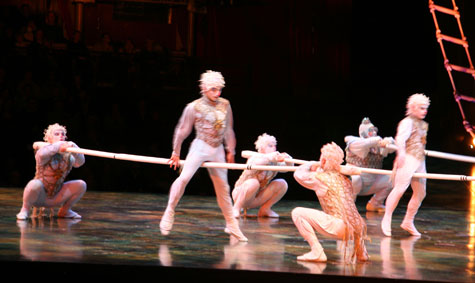
SADNESS AND AFFIRMATION Alegría runs the gamut of emotions.
|
Calling Cirque du Soleil a circus is like calling Cinderella's splendiferous carriage a pumpkin. They're starting their 25th anniversary tour at the Dunkin' Donuts Center in Providence (July 2 through 5) and, compared to Cirque, an ordinary circus appears vegetative, indeed.
"As a genre, I can't bear it," says Michael Smith, the artistic director of Alegría, the show that Cirque will be presenting. He hates the unimaginative music at circuses as well as the exploitation of animals for our amusement.
As for Cirque, "I see that more as theater in a tent than a circus," Smith says. "It's got the best parts of a circus, with the acrobatics that thrill people. If you go to the circus, you want to see people do things that you could never do and you couldn't dream another person would even think of doing. That element's still there."
Speaking from Montréal, Cirque du Soleil's home base, Smith noted that Alegría, created in 1994, was changed significantly earlier this year. He brought in the original creators to restage it from a show for the big top to one for arenas like the Dunk. Among the many shows that Cirque has created, Alegría is the favorite of Guy Laliberté, who formed the company with Daniel Gauthier in 1984.
Cirque has produced 15 shows and is currently touring eight of them simultaneously, having made 250 stops in more than 100 cities around the world in the last quarter-century.
Alegría is the darkest of all their creations — despite being Spanish for joy, the exclamation "Alegría! Alegría! Alegría!" expresses, on occasions of sadness, the affirmation that life must go on. The performance maintains a contrast between age and youth, weakness and strength, abusive power and frustrating powerlessness. For example, the show has characters costumed as old birds huddling together, representing conservative establishments, contrasting with ethereal angels wandering about, as young people do. There are 55 elaborately costumed performers, from acrobats and contortionists to singers and clowns, unfolding two hours that are part storyline, part state of mind.
"I've seen the show many times, and I'm still surprised when I catch certain things that I haven't seen before," Smith says.
He sees the somber dimension as amplifying the show's subject matter. "Tears can be tears of joy, they don't always have to be tears of sadness. So that's the theme that goes through. I think an important message to take from the show is that it's really important that we as humans hold our hands out to our neighbors."
The artistic director has had 15 years of experience performing, as "a song and dance man," as he put it, in musical theater. As a dancer he was familiar with the mechanics of bodily movement, so he became "hugely interested" in learning about acrobatics in the course of dealing with Cirque performers. He spends a lot of his time recasting the show, looking at acts, and deciding what they can bring to Alegría. "At the required technical level, there are not that many available. We're taking the crème de la crème.
"It's not a book musical, it's much more a concept musical," Smith points out. "So individual input develops the creativity of all the people who interact with them as well. It's that kind of liberalism that permeates everything, and I think it's a really big reason why Cirque is successful and why so many people stay working for the company for a very long time."
New performers stay in Montréal for six to nine months, working on their specific act as well as taking acting and singing and movement classes — and English classes for many, with more than 40 countries represented by the 3500 employees of the organization.
"The creative process that they go through is unlike anything I've seen," Smith says. "The investment the company makes in each artist as an individual makes them feel very respected, so they want to give, they want to come up with fresh ideas — but want to come up with something different, they want to make their mark."
We'll soon be able to see the results of all that trouble. Indications are that we'll be impressed.